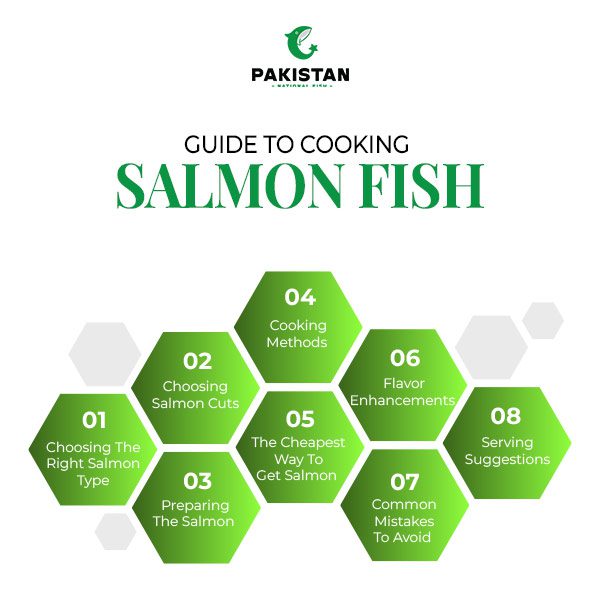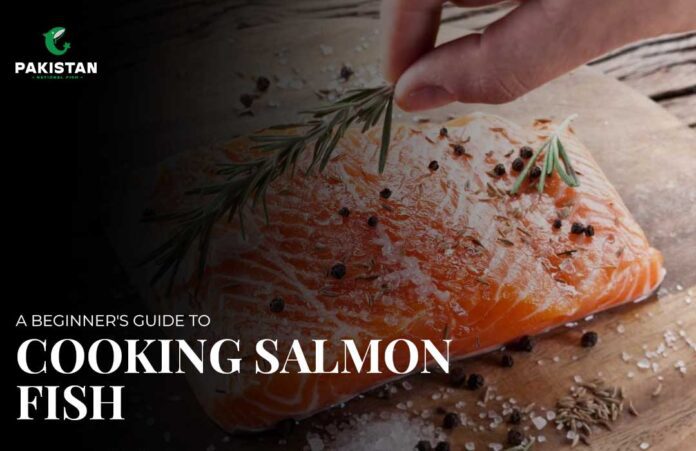Salmon is a delicious and very healthy fish that makes a great meal choice for amateur and professional cooks. Because there are different types of salmon fish with different flavours and textures, salmon can be cooked in different methods to satisfy the taste of the consumers.
Going from rich King salmon located in Alaska to smoked Copper River salmon there is a lot to try out.
Tips for Cooking Salmon Fish

1. Choosing the Right Salmon Type
- Alaskan King Salmon (Chinook): Known for its high oil content and rich flavour, Alaskan King Salmon is often ranked as the top choice. It’s excellent for grilling, roasting, and cooking methods where the salmon’s natural taste shines.
- Ora King Salmon: Preferred for sashimi and fine dining due to its buttery smooth texture and refined flavour, Ora King Salmon is best suited for special occasions, commonly found in high-quality bars and restaurants.
- Copper River Salmon: This prized salmon from Alaska’s Copper River is rich in Omega-3 fatty acids with a firm, mildly sweet flavour, making it perfect for grilling, roasting, and smoking.
- Sockeye, Coho, and Atlantic Salmon: Easily available and milder in flavour, these types are ideal for a variety of spices and marinades. While Atlantic and Sockeye Salmon are accessible and affordable, the premium Alaskan King and Copper River Salmon are perfect for special treats, though at a higher price.
2. Choosing Salmon Cuts
- Fillets: This one is the most popular cut and is suitable for the newbies as well as friendly for pan searing baking, and grilling.
- Steaks: Thicker compared to fillets, salmon steaks have more bone that gives more taste when being cooked. They are good for barbecuing and can stand marinating adverse.
- Whole Salmon: Whole fish is more versatile than cut servings, offering an elegant appearance and taste. Fillets are the cheapest cuts of salmon, easily portable, and available in grocery stores.
3. Preparing the Salmon
- Check for Bones: It is even possible that boneless fillets contain small pin bones. Any you find should be removed with the help of tweezers.
- Season Lightly: The rich taste of salmon does not require excessive addition of spices: just salt, black pepper, and olive oil are enough.
- Dry the Fish: Take a paper towel and dab off the liquid from the salmon. This aids in attaining well-crinkled skin if one is pan-burning or barbecuing.
Cooking Methods for Salmon Fish
1. Pan-Seared Salmon:
- Heat the Pan: Let it heat on medium-high with a non-stick or cast iron skillet.
- Add Oil: Lubricate with olive oil or butter, in either case, put the oil once the pan is very hot.
- Place Salmon in the Pan: Place the fillet skin side down on a flat surface whether working on it or barbecuing it. Stir for 4-5 minutes, then flip it and continue to stir for 2-3 minutes until done.
2. Baking Salmon
- Preheat Oven: Set it to 400°F (200°C).
- Prepare Salmon: Arrange seasoned fillets on a baking tray lined with a piece of foil.
- Bake: Take about 12-15 minutes, depending on the thickness of the dough, so that it can flake when it is pricked with a fork.
3. Grilling Salmon
- Preheat Grill: Prepare it to medium-high and then oil the grates of the grill.
- Place Salmon on Grill: Lie skin side down on the grates.
- Grill: Grill for 4-5 minutes on both sides or until the fish will flake.
Meats should be another dish as steaks are perfect to grill because they stay together on a grill bar better than fillets.
The Cheapest Way to Get Salmon
- Buy in Bulk: It can be less expensive to buy a whole salmon and then divide it up on your own.
- Look for Frozen Options: Specifically, they point out that it is better to buy fresh salmon or frozen one as it is as tends to be as nutritional and significantly cheaper. It is best served when thawed slowly in a refrigerator.
- Canned Salmon: Very versatile for the preparation of salmon cakes, salads, or even for addition to pastas, canned salmon is cheaper.
Flavor Enhancements
Salmon’s mild taste pairs well with many seasonings and sauces:
- Citrus and Herbs: Lemon, dill, and parsley have a clean fresh taste to them.
- Spices: Smoked paprika warms up the dish and garlic powder lends depth in the form of flavour.
- Sweet and Savory Glazes: Using sweet-flavored foods it is good to try honey mustard or maple soya glazes to balance the taste of these foods.
- Asian-Inspired Marinades: Incidentally, salmon goes well with soy sauce, sesame oil, and ginger.
Try Something New: Salmon Jerky
As a different preparation try preparing or purchasing salmon jerky. It is commonly consumed with attractions of smoked specification and relatively opaque in all its kinds. It is prepared by soaking thin pieces of salmon in soy sauce, honey, and spices then placing the pieces in the over or dehydrating machine at a low temperature.
This is a portable snack that involves a lot of protein and makes the flavour of salmon quite different but quite palatable.
Common Mistakes to Avoid
- Overcooking: For the moist type, set and retain an internal temperature of 125°F to 130°F.
- Not Seasoning Enough: Salmon is quite flavorful on its own so don’t be afraid to season it; even a pinch of salt goes a long way.
- High Heat: Common techniques include using medium heat to brown the outside without overcooking it.
Serving Suggestions
- Vegetables: Give roasted asparagus, broccoli, or green beans a shot.
- Grains: The stuffing used in the dish should be that rice, quinoa, or couscous.
- Salads: Salad – avocado and a glass of vinaigrette.
- Sauces: Additional flavours include lemon-butter sauce, tartar sauce, or tzatziki.


